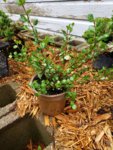Cable
Omono
So, yesterday I was scouting a small nursery I'd never been to. I was told I had to check it out because they had a lot of bonsai stuff... which they did but not much I was interested in. Most of their stuff was really young and I have plenty of that.
BUT, the guy pointed out that two of his starters were birches with one being labeled as "Dwarf Birch - World's Smallest". The guy said it had the smallest leaves of all the birches. Now, I love birches. My old house had three of them and soon after moving into my new one I planted one out front. I couldn't pass up a dwarf birch, whatever the hell that was! I figured I'd learn about it when I got home.
Au contraire! There is not a lot of info out there about these except that they're native to the arctic and hardy to zone 2. Natural form is as a shrub not more than 3' high.
Anybody have experience with these things? Am I just going to kill it seeings as I'm in zone 6? I do plan to pop it in the ground for a few years. The nurseryman said to let it get morning sun and then shade the rest of the day. Other than that I have no idea how to care for this little guy.


Ignore the doggo in the second pic. lol.
BUT, the guy pointed out that two of his starters were birches with one being labeled as "Dwarf Birch - World's Smallest". The guy said it had the smallest leaves of all the birches. Now, I love birches. My old house had three of them and soon after moving into my new one I planted one out front. I couldn't pass up a dwarf birch, whatever the hell that was! I figured I'd learn about it when I got home.
Au contraire! There is not a lot of info out there about these except that they're native to the arctic and hardy to zone 2. Natural form is as a shrub not more than 3' high.
Anybody have experience with these things? Am I just going to kill it seeings as I'm in zone 6? I do plan to pop it in the ground for a few years. The nurseryman said to let it get morning sun and then shade the rest of the day. Other than that I have no idea how to care for this little guy.


Ignore the doggo in the second pic. lol.

